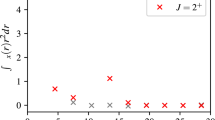Abstract.
The inclusive reactions and are studied with the Lorentz integral transform method. The method allows the inclusion of the full final-state interaction without explicit knowledge of the continuum states. Features of the inversion procedure are discussed in this work. The technique for the calculation of the matrix elements of the Hamiltonian is described. The total photoabsorption cross section of 3H is calculated with a realistic super-soft-core NN force. In the threshold region the cross section is rather similar to that obtained with central forces only, while in the peak the realistic NN interaction leads to more strength. For the longitudinal (e, e′) response we extend our calculation with a semirealistic force to MeV/c. Rather good agreement with experimental data is found. The accuracy of the quasielastic response approximation is discussed.
Similar content being viewed by others
Author information
Authors and Affiliations
Additional information
Received August 15, 1998; revised February 22, 1999; accepted for publication March 9, 1999
Rights and permissions
About this article
Cite this article
Efros, V., Leidemann, W. & Orlandini, G. Electromagnetic Few-Body Response Functions with the Lorentz IntegralTransform Method. Few-Body Systems 26, 251–269 (1999). https://doi.org/10.1007/s006010050118
Issue Date:
DOI: https://doi.org/10.1007/s006010050118




